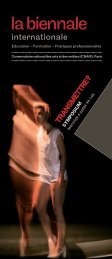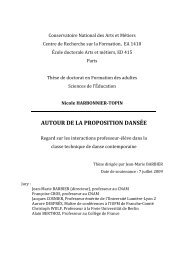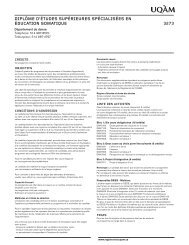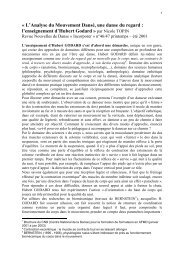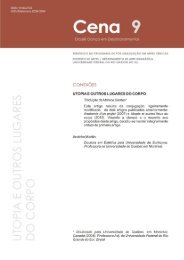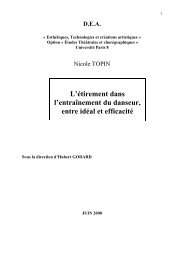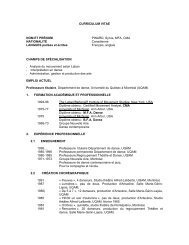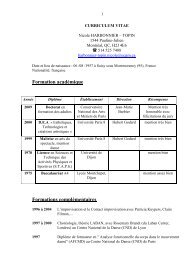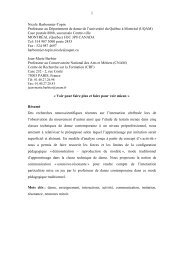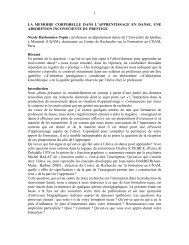Day 2 - Département de danse - UQAM
Day 2 - Département de danse - UQAM
Day 2 - Département de danse - UQAM
Create successful ePaper yourself
Turn your PDF publications into a flip-book with our unique Google optimized e-Paper software.
“Three Women’s Festivals, Many Voices: Groundswell, FemFest, and The Riveter Series.”<br />
Shelley Scott (University of Lethbridge)<br />
In her 2005 Theatre Topics article examining the Women’s One World Festivals, Lara Shalson uses the i<strong>de</strong>a of “subaltern<br />
counterpublics” to explain the importance of women’s theatre festivals, unpacking assumptions about the role of the critic, the<br />
function of <strong>de</strong>grees of separatism, and the oft-heard charge of “preaching to the converted.” Shalson argues that work done<br />
within the sphere of a women’s festival, because it is “freed temporarily from dominant critical perspectives,” will find “the<br />
necessary conditions for these artistic innovations to ultimately challenge dominant performance paradigms at the level of<br />
content and form” (Lara Shalson, “Creating Community…”).<br />
Taking Shalson’s terms for my own analysis, I will compare the most recent iterations of three Canadian women’s theatre<br />
festivals: Groundswell, FemFest, and The Riveter Series. Looking to the CATR 2013 conference theme, @ the edge, this<br />
paper will consi<strong>de</strong>r whether a women’s theatre festival is an event of self-imposed marginalization, if a women’s festival can<br />
truly be a place to explore diversity and support emerging artists, and how works created for a festival context speak back to<br />
the authority of the mainstream.<br />
Nightwood’s annual Groundswell festival has been held in Toronto since 1986, but in 2011 it was re-bran<strong>de</strong>d as The New<br />
Groundswell. In March 2013, The New Groundswell will feature productions of three new plays, including Judith Thompson’s<br />
Who Killed Snow White? which was also read in excerpt at the 2012 FemFest. Presented by Winnipeg’s Sarasvati<br />
Productions, FemFest celebrated its tenth anniversary in September 2012. Calgary’s Urban Curvz was foun<strong>de</strong>d in 2005, and<br />
May 2013 will mark the second time they present The Riveter Series, their annual festival. On their website, Urban Curvz’ s<br />
artistic team has <strong>de</strong>scribed the Riveter event as being inspired by FemFest and Groundswell. By taking a close look at the<br />
most recent editions of these three generations of festival, and by speaking with their artistic directors, I will draw comparisons<br />
between intentions, purposes, and reception, focusing specifically on notions of “community-based,” “political,” and<br />
“professional” theatre, to consi<strong>de</strong>r how these events provi<strong>de</strong> a counterpublic space for women.<br />
“‘Miss Behave’ in TruDynasty Carnival’s 2012 ‘Gar<strong>de</strong>n of E<strong>de</strong>n’ Mas: Biblical Eve goes<br />
Bacchanal at Caribbean Carnival.” Jacqueline C. D. Taucar (University of Toronto)<br />
Over a million spectators line the Scotiabank Toronto Caribbean Carnival para<strong>de</strong> route to watch groups of Masquera<strong>de</strong>rs (Mas<br />
Bands), in elaborate costumes called “Mas” (Derived from masquera<strong>de</strong>, the masking of the self to perform alternative<br />
i<strong>de</strong>ntities), create a kinesthetic landscape of colour as they wine and dance along Lake Shore Boulevard. Mas is more than<br />
just the costume alone. Rather, it becomes Mas through performance, as Ferris and Tompsett contend, “when the player plays<br />
it, connecting to its meaning from insi<strong>de</strong> him/herself and giving that character or thematic aspect full life on the street” (47).<br />
This paper will examine Michelle Reyes performance of TruDynasty Carnival’s 2012 Queen costume, “The Gar<strong>de</strong>n of E<strong>de</strong>n”<br />
(hereafter “E<strong>de</strong>n”), at the Caribbean Carnival’s King and Queen Competition. “E<strong>de</strong>n” reimagines Biblical Eve within the<br />
carnival aesthetic and in doing so opens up new ways of reading and interpreting Eve’s so-called Fall in Genesis and posits a<br />
post-colonial, counter-discursive view of women in the story, in carnival and in society. The “E<strong>de</strong>n” Mas and its performance at<br />
can be read as an example of what Helen Tiffin calls a “canonical counter-discourse” in which, “a post-colonial writer [or<br />
performer] takes up a character or characters, or the basic assumptions of a … canonical text, and unveils those assumptions,<br />
subverting the text for post-colonial purposes” (100). Helen Gilbert and Joanne Tompkins (1996) contend that the Bible, in<br />
aiding and abetting the imperial project, is ripe for post-colonial intervention. Women as Eve have been constructed in<br />
Western, and colonial, culture as the root of temptation and sinfulness for having first succumbed to evil. Caribbean women<br />
are objectified via a male-oriented, colonizing gaze, which has constructed racist and sexist stereotypes and fantasies of the<br />
black female body and sexuality. Ownership of a slave’s body inclu<strong>de</strong>d access to the sexual services, consensual or by force.<br />
TruDynasty’s “E<strong>de</strong>n” challenges the imperial, patriarchal and misogynistic gaze in the story of Adam and Eve by re-writing the<br />
Eve’s story to transform from an innocent to a knowing being, eschewing shame, and instead embrace the carnival license to<br />
enjoy and celebrate the body—especially the female body—on her own terms.<br />
c) “Talking and Walking”: PBR/PaR Design, Methodology, Articulation (to 5:30pm) McIntyre<br />
Seminar Organizer: Bruce Barton (University of Toronto). Participants: Conrad Alexandrowicz<br />
(University of Victoria), Henry Daniel (Simon Fraser University), Natalie Doonan (Emily Carr<br />
University, 2013 CATR Theatre practice award winner), Natalia Esling (University of Toronto),<br />
Patrick Finn (University of Calgary), Chris Jackman (University of Toronto), Monica Pren<strong>de</strong>rgast<br />
(University of Victoria), Lauren Shepherd (University of Toronto).<br />
It has become a familiar un<strong>de</strong>rstatement that “Practice-Based Research” (PBR) and “Performance as Research” (PAR) are<br />
contentious categorizations. Both in Canada and internationally much energy has been <strong>de</strong>dicated to sorting through the<br />
multiple variations of these terms (“artistic research,” “arts-informed research,” “reflective practice,” etc.). The early, high profile<br />
initiative at the University of Bristol, PARIP (Practice as Research in Performance, 2001-06), remains a conspicuous<br />
touchstone in the PBR discussion, given its pronounced emphasis on issues of methodology and documentation/<br />
dissemination. In particular, PARIP foregroun<strong>de</strong>d the myriad challenges facing performance training and scholarship in higher<br />
education contexts. It also <strong>de</strong>monstrated how the articulation of PBR and PaR “best practices” is not only an artistic, scholarly<br />
and pedagogical imperative, but a political and strategic one as well. In the <strong>de</strong>ca<strong>de</strong> since the launching of PARIP, PBR and<br />
PaR practitioners, projects, and programs have proliferated, on this continent and internationally. And while the conversation<br />
today has only increased in complexity, many of the same issues that preoccupied the PARIP ‘pioneers’ remain central to the<br />
current discourse.[…]<br />
33



